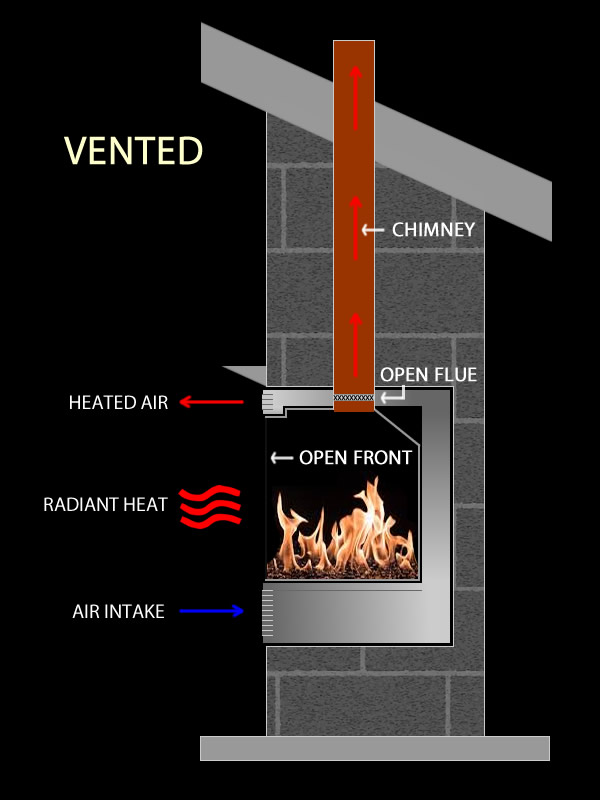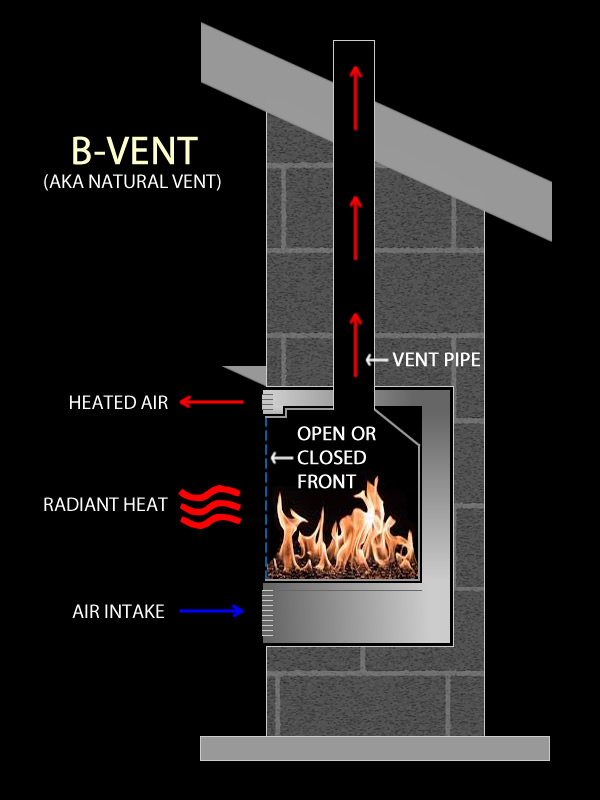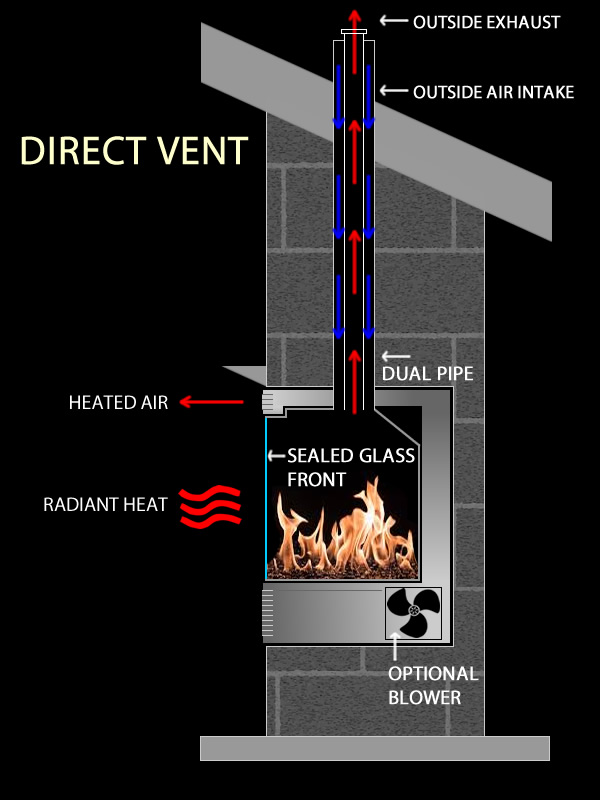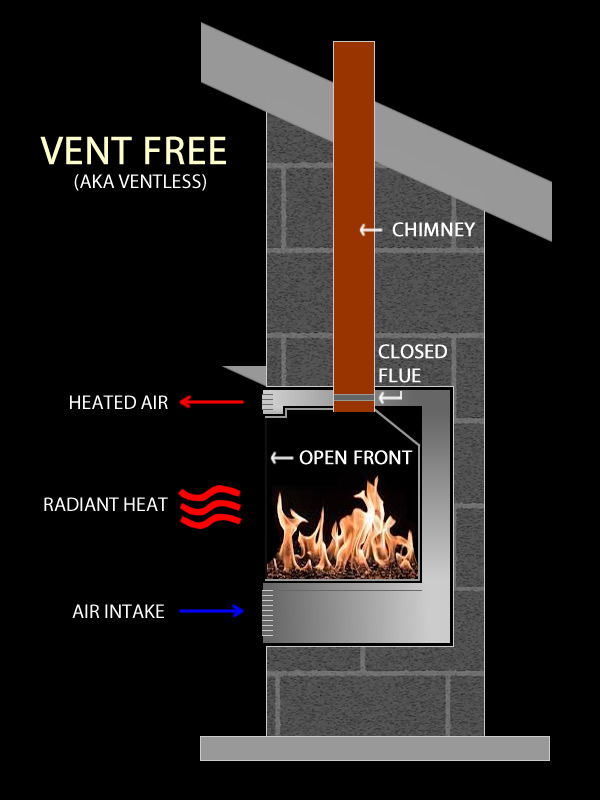Learn the Difference - Vented | B-Vent | Direct Vent | Vent Free

Vented Products
Requires a fully functioning fireplace with a working chimney
If you have a functioning wood-burning fireplace and want the ambiance of a real wood fire, than vented gas logs, by far, offer the most realism. The fire wraps around the logs like they would in a real wood fire and the yellow flames are generally taller than those in a vent-free system.
Just like burning wood, vented gas logs produce Carbon Monoxide emissions. Because of this, it can be dangerous if they are not properly vented to the outside through an open chimney. You will need the damper or flue to be open so you will lose more heat than you would with a vent-free set which is why vented gas logs are mainly considered decorative.
With vented gas logs, there is some flexibility with arranging the logs as long as you leave some room between the logs for airflow and to prevent soot build-up. You can add decorative gas log accessories such as pine cones, branches, & wood chunks to customize your fireplace.
PROS:
- The most realistic looking gas logs and dynamic flames.
- They make use of an existing functioning wood-burning fireplace.
- The taller yellow flames enhance the realism of vented gas logs
- Can be less expensive than their vent-free counterparts.
CONS:
- Not as much warmth as vent free sets since the heat is directed out the chimney.
- You must have a fully functioning wood-burning fireplace or you cannot use these.
- Since the flame is touching the logs, vented gas logs produce more soot and will need to be cleaned more often than their vent-free counterparts.

B-VENT Products
A B-Vent must always terminate vertical. It cannot be terminated to an outside wall
B-Vent appliances use pipe (b-vent) that must be installed through the home and terminate above the roof. B-vent appliances use a single exhaust pipe and draw combustion air from the room into the combustion chamber and up through the chimney, but the amount of air they use is minimal. These devices are sometimes referred to as “natural-vent”.
The biggest difference in B-Vent vs. Direct Vent is that the Direct Vent appliances are sealed to the room. They draw their combustion air from outside and exhaust through a collinear or coaxial pipe. In either case, efficiencies on new appliances don’t vary much between the two configurations. Most new gas stoves and fireplaces use very small 3″ or 4″ diameter exhaust systems.
B-Vent systems are designed for negative pressure applications and flue gas temperatures should not exceed 400°F above ambient room temperature for this category of appliance.
PROS:
- Combustion fumes are vented outside.
- B-vent pipe itself is relatively inexpensive and simple to install.
- B-vent appliances are relatively efficient.
CONS:
- B-vent must be installed through the interior of the home and terminate above the roof which may pose extensive installation labor costs or difficulties depending on the home.
- B-vent could potentially be a source of cool air into the living area if a downdraft occurs.
- Some of the heat from the appliance is lost up the vent.
- Not a popular choice anymore due to it's direct vent counterpart and has been discontinued by many manufacturers.

Direct Vent Products
Direct Vent can not only terminate vertical but also go outside of your wall
Direct Vent fireplaces are an excellent way to create a warm and inviting focal point without affecting the quality of your indoor air.
In direct-vent appliances, you use special direct-vent pipe recommended by the supplier. The direct-vent system involves two parts, one part for the exhaust and one for combustion air intake. They use a completely sealed venting system to draw in fresh outside air for combustion while simultaneously exhausting harmful byproducts and combustion gases out of the home. The front of the firebox is completely sealed off from the interior of the home to allow the venting system to work efficiently while preventing combustion gases from entering the living space. The exhaust vents can either go out through a side wall, through the roof or the pipe can be run up an existing chimney. Direct Vent fireplaces put out a decent amount of heat and operate with up to 85% efficiency. With the addition of a fireplace blower, more heat can be pushed from the firebox out into the living area.
PROS:
- Combustion fumes are vented outside.
- A simple installation in most cases where the vent can go out a wall and terminate at the wall.
- No need to terminate above the roof line as is necessary with b-vent or wood burning applications resulting in relatively low venting costs.
- Direct-vent appliances are typically higher in efficiency than b-vent appliances and put out a lot of heat even with a low flame setting but still do not produce as much heat as their vent free counterparts.
CONS:
- Direct fireplaces have a sealed glass front and typically a smaller flame than a b-vent fireplace or a vent-free fireplace.
- The position and look of the logs in the fireplace cannot be altered or incomplete combustion will occur.
- The vent pipe is a little more expensive.

Vent-Free Products
One of the most popular options to add a focal point to your living space
If you’re looking for an efficient way to heat your home, vent free gas logs may be a great option for you. Unlike their vented counterparts, vent free gas logs don’t need a chimney or flue to function (though they can be installed in a functional fireplace with the damper open or closed). Because of this, most of the heat stays in your home and serves as a great way to heat a space. What you gain in heating you lose a bit in appearance as vent free gas logs tend to be a little less realistic. Also, vent free gas logs and fireplaces are not allowed in California or Massachusetts, as well as other areas of the US. Before purchasing and installing a set in your home, you’ll want to double-check that your region and building codes allow them.
To avoid carbon monoxide emissions, the flame has to avoid touching the logs and it is highly recommended to have the logs serviced annually. The gas logs must remain in the arrangement specified by the manufacturer. You can still enjoy a beautiful view while heating your home.
PROS:
- Greater heat output makes them a great way to warm your home quickly and efficiently.
- Most vent free gas logs can be installed either in a fully functioning wood-burning fireplace or in a factory-made vent free fireplace but you will want to refer to your gas log’s manual to find out specifically where they can be installed.
- More environmentally friendly because the fuel burns almost completely, producing less pollution.
- They use slightly less fuel than their vented counterparts.
CONS:
- Can’t be customized very much. You can’t use decorative items in the flames and you can’t rearrange the logs.
- Can’t be upgraded. Whichever logs and ignition method you choose is what you get. You can’t upgrade to a remote option later on if you don’t buy that type from the beginning.
- Produces humidity in the room. If you don’t crack a window sufficiently then you could run into related issues such as peeling paint. however, If you live in an area with a dry winter, the humidity can actually be beneficial in making your home more comfortable.